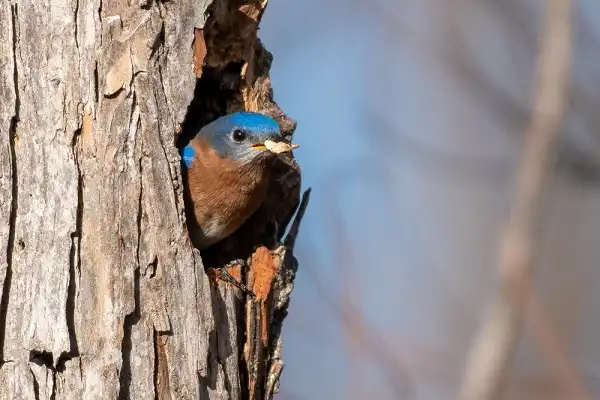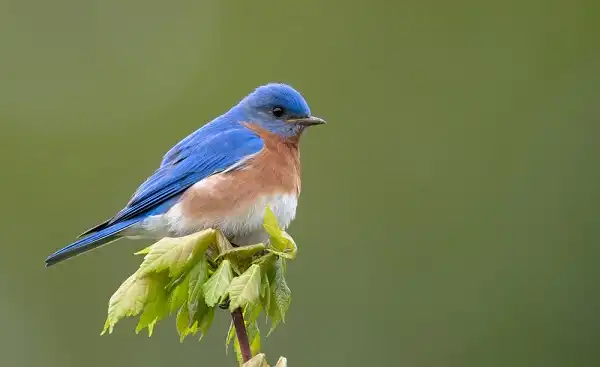The Eastern Bluebird (Sialia sialis) is a small bird native to the eastern and western parts of North America. It is a member of the thrush family and can be found in open grasslands, meadows, and fields as well as suburban yards. The Eastern Bluebird has an unmistakable bright blue back, wings, and tail, making it a popular bird to spot. The male Eastern Bluebird is especially striking with its brilliant red chest and throat.

Eastern Bluebird Description
The Eastern Bluebirdhas a large head with a short tail and a rounded body shape. Its wingspan ranges from 11 to 13 inches wide, making it easy to spot as it flies through the air. The male Eastern Bluebird has bright blue feathers on its back, wings, and tail, while the female has duller brownish-blue feathers with some white spots mixed in. The male also features a bright red chest and throat that contrasts sharply with its blue back feathers.
Eastern Bluebird Habitat
The Eastern Bluebird is found in both the eastern and western parts of North America. Its preferred habitat includes open grasslands, meadows, and fields as well as suburban yards. It is also commonly seen perching on posts, fences, or other elevated surfaces.
Eastern Bluebird Diet
The Eastern Bluebird primarily feeds on insects and other invertebrates. It will also eat some berries, fruits and seeds when available. It prefers to feed in open areas such as meadows, fields or lawns, where it can easily spot its prey.

Eastern Bluebird Size
The Eastern Bluebird is a small songbird, measuring approximately 6.3 to 8.7 inches in length and weighing between 0.9 and 1.2 ounces. Its wingspan ranges from 11 to 13 inches wide, making it easy to spot as it flies through the air.
Eastern Bluebird Lifespan
The Eastern Bluebird typically lives for around 6 to 8 years in the wild. In captivity, they can live up to 10 years.
Eastern Bluebird Behavior
The Eastern Bluebird is an active bird that spends much of its time foraging for food. When it finds a suitable perch, such as a fence post or telephone wire, it will often remain there for many minutes at a time. It can also be found perching on trees and shrubs when searching for prey.
Eastern Bluebird Breeding Habits
The Eastern Bluebird breeds from April to August each year. It builds its nest in cavities, holes in trees or buildings and nest boxes. The female typically lays 3 to 5 eggs which incubate for 14 to 16 days before they hatch. The chicks are dependent on their parents for food and protection until they are ready to leave the nest after around 21 days.

Eastern Bluebird Conservation Status
The Eastern Bluebird is considered to be of Least Concern on the IUCN Red List. The population is stable, though it has been affected by habitat loss and competition from other birds for nesting sites. Conservation efforts are underway to protect and restore its habitats, as well as to create more suitable nesting opportunities such as nest boxes.
Eastern Bluebird Speed
The Eastern Bluebird has an average flight speed of 24 mph, though this can vary depending on the bird’s size and weight.
Eastern Bluebird Sounds
The Eastern Bluebird has a variety of birdsongs used to communicate with other birds. It also makes a loud “chek-chek-chek” sound when alarmed or agitated. It is also known to make soft chirping noises when courting a mate or during nesting season.

Conclusion
Overall, the Eastern Bluebird is an interesting and colorful bird that can be found in many parts of North America. Its bright feathers are easy to spot in its grassland habitat as it flies through the air or perches atop posts and fences searching for prey. With proper conservation efforts, we can ensure that future generations will continue to enjoy this beautiful species in their own backyards. We hope you have learned something new about this beautiful songbird!
Frequently Asked Question

